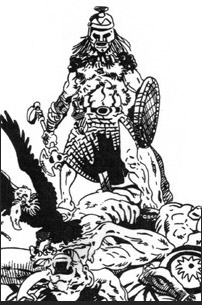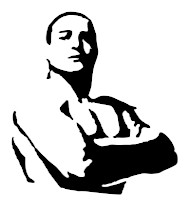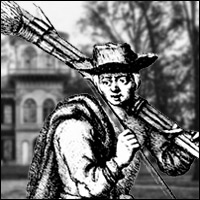Books 3 and 4 of Metamorphoses focuses on the foundation of Thebes, the Phonecian connection with prehistoric Hellas, the deeds of heroes and nymphs, the crimes, curses and blessings of gods, the polarity of Heaven and Hell, and of Africa. Book 3 begins with a narration of how Jupiter is continuing his destruction, discipline and rape of mankind through more subtle means then before. Taking books 1 thru 4 together, one may draw the following parallels between Zeus-Jupiter-Jove-Almighty and the God of the Bible.
-1. Possessed a sacred tree
-2. Created man in his divine image
-3. Punished man by fire & brimstone
-4. Cast out lesser powers from Heaven into Hell
-5. Possessed a sacred mountain [Ida and Sinai]
-6. Fathered heroic men upon virgin women
-7. Punished man by flood
-8. Accepted entry into heaven of his earthly son [Herakles and Jesus]
-9. Commanded lesser powers to communicate with, aid and punish humans on his behalf.
-10. Demanded sacrifices.
-11. Demonstrated an emotional connection to humanity to include rage.
-12. Is more powerful than all other superhuman agents combined.
Do note that the antiquity of the cults of these two Almighty Gods are parallel with the first evidence for both being circa 1800 to 1600 B.C. However, these dates [old as they are coming from a 1998 reading] only reflect what we have found to have been written, which might have little to do with what was written, as most of ancient literature was lost at least twice.
Again, with 12 nearly exact characteristics, and the obvious fact that most of what pagan ancients called gods were minor powers corresponding to devils, demons, angels and archangels, it is quite easy to see that the faith of Paul, born at the very time that Ovid wrote in his island exile would soon find wide appeal where the cult of Jove was supreme.
Book 3 begins with Cadmus, a son of Zeus, destined to know nothing but sorrow and be turned into a snake, founding Good-cattle-land, where Thebes would be founded and be erased by Alexander. Zeus was the God of the sky and had eagles, as Odin had ravens to do his bidding. After the myth of Io being raped by Zeus and migrating as an afflicted cow, Cadmus is told to find a place where cattle have not been yoked and settle there. These are obviously vestiges of herder migrations after social copllapse. Note that in Exodus, where God is most Zeus-like, that his back sliding migrants construct a golden calf.
There is much evidence in Ovid, as in Virgil, Homer and Apollonius, and in the epics of Gilgamesh and Beowulf, that these ancient tales were echoes of ancient migrations associated first with the Arуan conquest of civilizations and primal tribes from Siberia, to India, to the Black and Middle Seas and all the way to Egypt, the Atlas Mountains of Morocco and the British Isles.
Cadmus and Perseus, in books 3 and 4, respectively, are sons of Zeus, of the big sky cattle lands [1], who battle great snakes, also referred to as dragons. The three snake-haired sisters of night, the Furies down in hell, reflect this, as does the gorgon Medusa, who was transformed from a beautiful woman into wrath by an offended goddess. Likewise, some heroes are transformed by offended resident goddesses into animals, some driven insane by goddess intercession via the Furies of hell. Nymphs and minor goddesses and even virgin women are conquered or offended by masculine sky gods or heroes of their bloodline.
This is obvious metaphor for the conquest of the Anatolian genetic race, in which the men were replaced and the women retained, and the suppression, subduction and persistence of their fertility snake cults. To this day national flags of nations speaking Arуan tongues use eagles as images of just dominance, with some of these eagles holding snakes, an image straight out of Ovid. The rapes of Persephone and of Europa are clear representations of this foundational marriage by conquest aspect of Western Civilization.
Earlier, in Book 1, Ovid points out how the Four Winds, powers subordinate to Jove, are prone to tear the earth apart in their various feuds, that Boreos [North Wind], Zephyr [Sunset Wind], Osser [Tropical Winds] and the Dawn Wind are at odds and man often pays the price. The postmodern anthropomorphic self deification cult of man-made global warming would strike Ovid as insane and impious as well. [2]
This, that natural climate mega-cycles catastrophic to man made civilizations, based as they are in intense and fragile grain cultivation, may trigger outward abandon migrations by cattle and ship as well as barbarian invasions by the same means. In Book 1 Ovid pointed out that the ship was the prime symbol of strife in the bloody Age of Iron.
This further brings to mind the various tails of dragons, of their toxic blood and poisonous breath, and that they slew and were slain by and gave birth to bloody-handed, iron-wielding men of war. These dragons might represent governments of a higher technology level than those recording their demise, and indeed those who struck them down. We do have unexplained construction from the period antedating 10,000 B.C. and the Younger Dryas Event. There are also the elements of winged steeds and flying chariots that suggest this, just as the extreme weight of weapons and mechanized rate of march of Gilgamesh and Enkidu suggest and echo of a heavy mechanized technology in antiquity, a technology, if it was an age of iron, and particularly submerged by flood, that would turn to rust in hundreds and thousands of years.
Perseus, in his battle with Atlas, was said to have contended with a leviathan gardener who kept a great dragon as a guard. Further, Ovid refers to Perseus traveling in the icy Atlas mountains, In Africa, of slaying a sea dragon and marrying an Ethiopian princess, on the back of a flying horse. These are easy metaphors for the Bronze Age Collapse, or perhaps of an early collapse of a great Atlantic civilization.
The serpent-dragon-goddess connection is brought into a mirror of our current managed feminine decline with the tale of Hermaphroditus [son of Hermes and Aphrodite] who an earth goddess effects a compromise sex change upon for spurning her. The turning to stone of Lot’s wife through her look back is an interesting inversion of Medusa’s power. Further, the turning to stone of male and female powers of titanic kind are thick within Ovid, from the Serpent to Atlas, again, serving up a possible post-cataclysmic metaphor.
The story of the betrayal and persecution of Dionysus or Bacchus, and of the three daughters of the orthodox king who abide their father’s wish not to engage in the Dionysian rites and tell stories to one another as they weave, is a fine piece of story within a story poetics. These women further suggest a reflection of the female editorial role today in our narrative, and that, perhaps, in the long ago, as women wove on their looms and spun thread they preserved tales by mouth that men like Ovid sent down to us by pen.
One of these women tells the tale of Babylonian Physbe, a tale of forbidden young love to explain the dark color of the mulberry fruit. This story is the obvious direct source for Romeo and Juliet. The fruit was stained with the blood of Physbe’s lover Phyramis, who slew himself at the base of the tree when he thought a lioness had eaten her on the way to their tryst, where she then killed herself as well, their blood drunk by the fruiting tree.
The vision of hell related by Ovid is the obvious source from which Dante operated in Inferno and Milton in Paradise Lost.
…
Notes
-1. For brevity and clarity, I prefer to use Zeus and Jove interchangeably. Note that Jove disguised himself as a bull.
-2. Impious is a common harsh judgment of poor character in Ovid.











